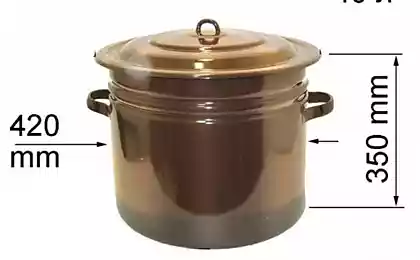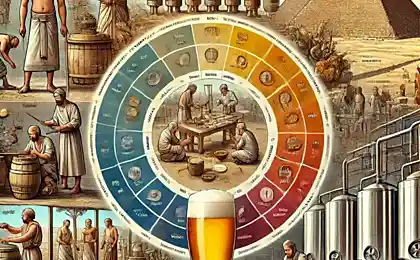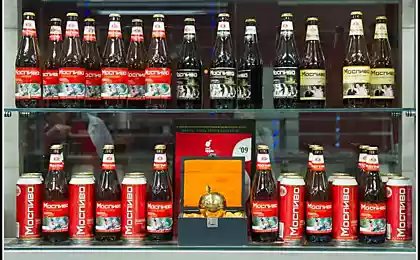775
11 interesting facts about the production of malt
As malt grain becomes and how one malts produced thousands of varieties piva
Technical Director of the malting plant "Soufflet" Alexander Gladilin shares the secrets of the malt production. He'll tell you exactly how grain becomes malt, and how one of the main varieties of malt can be cooked a thousand different beers.
http://podfm.ru/getplayer/pod/?rss=http%3A%2F%2Fbeer.podfm.ru%2F106%2Frss.xml&channel=embeddedplayer
1. Approximately 95% of malt for the brewing industry is made from malting barley. This malt is the principal raw material required for the production of beer. It contains extractives or sugar absorbed by the yeast during fermentation. The result is alcohol and carbon dioxide, which give the beer flavor desired range.

2. It should be noted that the malt - is germinated barley. When there was just malt, it is difficult to determine, but it is known that he was open slightly later than people began to brew beer. Beer also appeared almost simultaneously with the bread. Once a person in the Neolithic period has passed from a nomadic to a sedentary lifestyle, in his diet drinks were fermented, resulting in the first time, perhaps, purely by chance. However, people began to use the effect of fermented beverage preparation.
Malt was also obtained in ancient times empirically. Perhaps as a malt product of human hands and nature at the same time for about five thousand years.
3. for the Brewers Malt barley is preferred. The bottom line - in the mechanism of digestion. Any yeast, brewing alcohol, or absorb from the solution in which there are, first of all, sugar. In pure barley no sugars, it contains starch which can be cleaved to sugars in the presence of water and enzyme. During malting barley or another cereal grain embryo produces enzymes, releasing the starch and lead it into polurastvorёnnoe state. Next brewers in the cooking and fermentation and the camp shops hydrolyzed starch to sugars, and then become food of sugar yeast.
That is why the malt - an intermediate element between the grains and a must: it contains everything necessary for the normal course of the fermentation process - a sufficient number of polurasscheplёnnogo starch and enzymes that break down starch to the end. And, of course, in the malt contains substances that provide flavor and color of beer.
4. The range of malts is quite extensive. Malthouse produce, for example, caramel malt, Vienna, Munich-type: they are all different in terms of color, taste and origin. There is, for example, wheat malt. There are also rye malt, used most often in baking. However, these special malts occupy only a small number of the total number of processed malts.
The bulk is used for brewing malt - a light barley malt. From it you can cook a variety of beers, combining it with a variety of specialty malts. In addition, its quality can create almost any taste of beer.
5. Standard malting process takes about nine days. Before you start production within the malting plant, a lot of work done. It begins where the special growing malting barley. It differs from the feed barley protein content and other characteristics. Malting barley malt and allows to obtain, respectively, a beer with a low content of nitrogen and protein. With this beer has a foam and is not spoiled for a long time.
6. After receiving the grain begins the process of malting. Grain was purified, calibrated and transmitted to the soaking compartment where it is placed in water. Every day at the large beer manufactures 360 tonnes of grain are placed in the so-called soaking tubs, where the grain begins to absorb water. The embryo in each grain thus absorb oxygen and release carbon dioxide. While soaking in the tank compressed air is fed to germ suffocated.
The grain is soaked for two days, during which time water is changed periodically. At the same time the grain for some time, with little or no water remains actively vented to the fetus was comfortable.
7. After the process of soaking the moisture content of the grain is 40-44% depending on the desired quality of the malt. In this state, the grain has germinated, in other words, the fetus began proklёvyvatsya from the shell of grain and actively develop. Further, such a huge amount of water is not necessary. Then all the grain is transported to the Department of germination, which is placed in germination boxes on a large flat surface - area of one box is about 700 square meters. Grain is distributed evenly with a thin layer on the bottom of the mesh. From beneath the screen is constantly supplied fresh air, which provides a breath of grain and removes excess heat, since the grain during respiration emits large amounts of heat. That is why these rooms are not heated.
Grain stored in this room for five days. Periodically check it, Ted, measure its humidity and adjust the temperature if necessary. At this time, the embryo grows and develops. In nature, are almost the same changes, with one exception - usually of an embryo formed shoots and roots, in the process of becoming ears. On the malting process of producing the same stops after five days when the grain is stored sufficient quantity of enzymes, and then transmitted to the grain dryers.
8. Grain drying is carried out on the same principle as that of sprouting. Dryer - this is a big container with a mesh bottom where even layer stacked grain. But the bottom has not served cool and hot air, it is necessary to convert the green malt in the finished product, which, in fact, is the malt needed for brewing.
9. For each class has its own parameters of barley germination, soaking and drying. Drying pale malt takes place within two days. The drying temperature is gradually raised from 50 to 85 in degrees. This is necessary for a smooth removal of moisture from the grain. The final stage, called otsushkoy, necessary for the formation and decomposition of the gustatory range of certain substances, which could give a further taste of beer vegetables or straw, which can not be tolerated. It is necessary to ensure uniformity of drying for each individual grain to the entire mass of grain was fairly homogeneous.
The entire process takes place under strict control personnel. Naturally, works automatically temperature control system and air supply.
10. For you need a lot of caramel malt polurastvorёnnogo starch in corn to turn into caramel. For this grain tomyat - steam treated for a long time at a certain temperature. Then the grain is dried.
Roasted malt can be obtained from conventional light malt, fry it in a special roasting drum.
11. More for growing barley in the fields of quality control is carried out: the professionals are trying to eliminate all the negative factors affecting the quality of barley. Control begins with setting varietal purity. For each individual selected varieties of barley malting optimum mode to reveal all of its main advantages. Also for each individual varieties developed special regime charts its production in the field. In addition, experts malting plant two or three times over the summer visit elevators, which will be stored barley, and farms where it grows. At each stage of working professionals who really know their job.
via factroom.ru

Technical Director of the malting plant "Soufflet" Alexander Gladilin shares the secrets of the malt production. He'll tell you exactly how grain becomes malt, and how one of the main varieties of malt can be cooked a thousand different beers.
http://podfm.ru/getplayer/pod/?rss=http%3A%2F%2Fbeer.podfm.ru%2F106%2Frss.xml&channel=embeddedplayer
1. Approximately 95% of malt for the brewing industry is made from malting barley. This malt is the principal raw material required for the production of beer. It contains extractives or sugar absorbed by the yeast during fermentation. The result is alcohol and carbon dioxide, which give the beer flavor desired range.

2. It should be noted that the malt - is germinated barley. When there was just malt, it is difficult to determine, but it is known that he was open slightly later than people began to brew beer. Beer also appeared almost simultaneously with the bread. Once a person in the Neolithic period has passed from a nomadic to a sedentary lifestyle, in his diet drinks were fermented, resulting in the first time, perhaps, purely by chance. However, people began to use the effect of fermented beverage preparation.
Malt was also obtained in ancient times empirically. Perhaps as a malt product of human hands and nature at the same time for about five thousand years.
3. for the Brewers Malt barley is preferred. The bottom line - in the mechanism of digestion. Any yeast, brewing alcohol, or absorb from the solution in which there are, first of all, sugar. In pure barley no sugars, it contains starch which can be cleaved to sugars in the presence of water and enzyme. During malting barley or another cereal grain embryo produces enzymes, releasing the starch and lead it into polurastvorёnnoe state. Next brewers in the cooking and fermentation and the camp shops hydrolyzed starch to sugars, and then become food of sugar yeast.
That is why the malt - an intermediate element between the grains and a must: it contains everything necessary for the normal course of the fermentation process - a sufficient number of polurasscheplёnnogo starch and enzymes that break down starch to the end. And, of course, in the malt contains substances that provide flavor and color of beer.
4. The range of malts is quite extensive. Malthouse produce, for example, caramel malt, Vienna, Munich-type: they are all different in terms of color, taste and origin. There is, for example, wheat malt. There are also rye malt, used most often in baking. However, these special malts occupy only a small number of the total number of processed malts.
The bulk is used for brewing malt - a light barley malt. From it you can cook a variety of beers, combining it with a variety of specialty malts. In addition, its quality can create almost any taste of beer.
5. Standard malting process takes about nine days. Before you start production within the malting plant, a lot of work done. It begins where the special growing malting barley. It differs from the feed barley protein content and other characteristics. Malting barley malt and allows to obtain, respectively, a beer with a low content of nitrogen and protein. With this beer has a foam and is not spoiled for a long time.
6. After receiving the grain begins the process of malting. Grain was purified, calibrated and transmitted to the soaking compartment where it is placed in water. Every day at the large beer manufactures 360 tonnes of grain are placed in the so-called soaking tubs, where the grain begins to absorb water. The embryo in each grain thus absorb oxygen and release carbon dioxide. While soaking in the tank compressed air is fed to germ suffocated.
The grain is soaked for two days, during which time water is changed periodically. At the same time the grain for some time, with little or no water remains actively vented to the fetus was comfortable.
7. After the process of soaking the moisture content of the grain is 40-44% depending on the desired quality of the malt. In this state, the grain has germinated, in other words, the fetus began proklёvyvatsya from the shell of grain and actively develop. Further, such a huge amount of water is not necessary. Then all the grain is transported to the Department of germination, which is placed in germination boxes on a large flat surface - area of one box is about 700 square meters. Grain is distributed evenly with a thin layer on the bottom of the mesh. From beneath the screen is constantly supplied fresh air, which provides a breath of grain and removes excess heat, since the grain during respiration emits large amounts of heat. That is why these rooms are not heated.
Grain stored in this room for five days. Periodically check it, Ted, measure its humidity and adjust the temperature if necessary. At this time, the embryo grows and develops. In nature, are almost the same changes, with one exception - usually of an embryo formed shoots and roots, in the process of becoming ears. On the malting process of producing the same stops after five days when the grain is stored sufficient quantity of enzymes, and then transmitted to the grain dryers.
8. Grain drying is carried out on the same principle as that of sprouting. Dryer - this is a big container with a mesh bottom where even layer stacked grain. But the bottom has not served cool and hot air, it is necessary to convert the green malt in the finished product, which, in fact, is the malt needed for brewing.
9. For each class has its own parameters of barley germination, soaking and drying. Drying pale malt takes place within two days. The drying temperature is gradually raised from 50 to 85 in degrees. This is necessary for a smooth removal of moisture from the grain. The final stage, called otsushkoy, necessary for the formation and decomposition of the gustatory range of certain substances, which could give a further taste of beer vegetables or straw, which can not be tolerated. It is necessary to ensure uniformity of drying for each individual grain to the entire mass of grain was fairly homogeneous.
The entire process takes place under strict control personnel. Naturally, works automatically temperature control system and air supply.
10. For you need a lot of caramel malt polurastvorёnnogo starch in corn to turn into caramel. For this grain tomyat - steam treated for a long time at a certain temperature. Then the grain is dried.
Roasted malt can be obtained from conventional light malt, fry it in a special roasting drum.
11. More for growing barley in the fields of quality control is carried out: the professionals are trying to eliminate all the negative factors affecting the quality of barley. Control begins with setting varietal purity. For each individual selected varieties of barley malting optimum mode to reveal all of its main advantages. Also for each individual varieties developed special regime charts its production in the field. In addition, experts malting plant two or three times over the summer visit elevators, which will be stored barley, and farms where it grows. At each stage of working professionals who really know their job.
via factroom.ru
A total of 60 light-years away can be more than 2,000 planets suitable for life
In the Sahara is the "eye"


















